

Pew Research Center. There are about 488 million Buddhists worldwide, representing 7% of the world’s total population as of 2010.
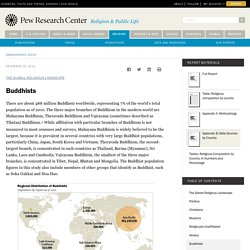
How American Buddhism is Like an Elephant. To understand Buddhism in the United States, it helps to start with an ancient Buddhist story.

A group of blind men describe an elephant. One, who feels the elephant’s tail, describes it as a rope. Another feels the head, and says the elephant is like a boulder. The other blind men, after feeling its tusks and its belly, describe the elephant as like a long staff or a large urn. The lesson: it’s complex, and depends on which part of the elephant you examine.
Buddhism first came to the United States via immigrants from Asia, and people of Asian descent still comprise the vast majority of American Buddhists, who are said to number anywhere from a million to five million. 5 facts about Buddhists around the world. Buddhists across Asia are preparing to celebrate the birthday of Prince Siddhartha Gautama, who later became known as Gautama Buddha and was the founder of Buddhism.
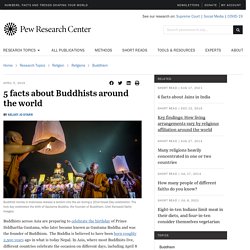
The Buddha is believed to have been born roughly 2,500 years ago in what is today Nepal. In Asia, where most Buddhists live, different countries celebrate the occasion on different days, including April 8 in Japan, May 12 in South Korea and May 18 in India and Nepal. The holiday goes by several names, including Buddha Purnima, Vesak, Buddha Jayanti and Ikh Duichen, and is often marked by national holidays, festivals and events at Buddhist temples. Here are five facts about Buddhists: Buddhists made up roughly 7% of the world’s population in 2015, but they are expected to decrease to roughly 5% by 2060. 2Half the world’s Buddhists live in China, according to 2010 Pew Research Center estimates.
Buddhism in Asia is a matter of both identity and practice. Differences From Other Religions. 1.
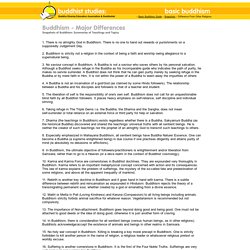
There is no almighty God in Buddhism. There is no one to hand out rewards or punishments on a supposedly Judgement Day. What makes a Buddhist and how do you become Buddhist? Buddhists generally describe themselves as happy people.

But becoming Buddhist doesn’t magically change the world around us to fit our needs. So what is it that changes? To be a Buddhist, we don’t need to wear any special clothing, change our eating habits, or give up material possessions or a social life. It’s as simple as changing our perception — not taking the obstacles that come our way so seriously, and seeing everything around us as interesting and full of potential. Simple to say but not always easy to do. By understanding the teachings and using tools like meditation, as Buddhists we gradually alter our view of whatever is happening in life. The Buddha’s teachings are a great treasury of helpful advice and each tradition emphasizes different aspects of Buddhism. Diamond Way Buddhists are lay people, often with families and regular jobs, who incorporate Buddhist methods into their daily lives.
What makes you a Buddhist? We need values that we can trust. The Pluralism Project. Ten misconceptions about Buddhism. Robert E.
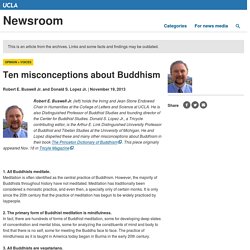
Buswell Jr. and Donald S. Lopez Jr. | November 19, 2013 Robert E. Buswell Jr. (left) holds the Irving and Jean Stone Endowed Chair in Humanities at the College of Letters and Science at UCLA. The Effects Of Buddhism In The Society - Buddhism Zone. Every religion always impacted positively or negatively to any society.

"Buddhism and Relationships" by Susan Piver. « "Sky-Gazing Meditation" By Lama Surya Das | "If the Buddha Used Twitter" by Soren Gordhamer » 1 March 2010 Buddhism has much to teach on the topic relationships, even though it may not seem that way at first.
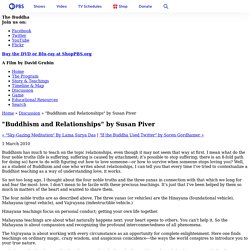
I mean what do the four noble truths (life is suffering; suffering is caused by attachment; it’s possible to stop suffering; there is an 8-fold path for doing so) have to do with figuring out how to love someone—or how to survive when someone stops loving you? Well, as a student of Buddhism and one who writes about relationships, I can tell you that every time I’ve tried to contextualize a Buddhist teaching as a way of understanding love, it works. So not too long ago, I thought about the four noble truths and the three yanas in connection with that which we long for and fear the most: love. The four noble truths are as described above. Hinayana teachings focus on personal conduct; getting your own life together. I made all this up, so please don’t take it too seriously. Three Yanas. The Buddhist Centre. Buddhism.
Buddhism is a non-theistic religion (no belief in a creator god), also considered a philosophy and a moral discipline, originating in India in the 6th and 5th centuries BCE.

It was founded by the sage Siddhartha Gautama (the Buddha l. c. 563 - c. 483 BCE) who, according to legend, had been a Hindu prince before abandoning his position and wealth to become a spiritual ascetic and, finally, an enlightened being who taught others the means by which they could escape samsara, the cycle of suffering, rebirth, and death. The Buddha developed the belief system at a time when India was in the midst of significant religious and philosophical reform. Buddhism was, initially, only one of many schools of thought which developed in response to what was perceived as the failure of orthodox Hinduism to address the needs of the people.
Buddhism's central vision can be summed up in four verses from one of its central texts, the Dhammapada: